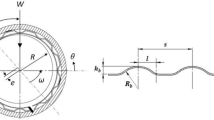Abstract
This paper presents a neural network predictor for analysing rigidity variations of hydrostatic bearing system. The designed neural network has feedforward structure with three layers. The layers are input layer, hidden layer and output layer. Two main parameter could be considered for hydrostatic bearing system. These parameters are the size of bearing pocket and the orifice dimension. Due to importancy of these parameters, it is necessary to analyse with a suitable optimisation method such as neural network. As depicted from the results, the proposed neural predictor exactly follows experimental desired results.
Similar content being viewed by others
Abbreviations
- P c :
-
Pocket pressure
- R d :
-
Outer radius of slipper
- R i :
-
Inner radius of slipper
- \(\bar P\) :
-
=Pp/Pc non-dimensional pressure
- P :
-
Pressure
- P p :
-
Supply pressure
- Q c :
-
Leakage from pool across slipper lands
- Q r :
-
Radial direction flow rate
- η:
-
Dynamic viscosity
- d e :
-
Diameter of orifice
- l c :
-
Length of orifice
- k c :
-
Orifice coefficient
- \(\bar h\) :
-
h/R d non-dimensional clearance
- k :
-
Bearing rigidity
- \(\bar k\) :
-
=k/P p R d non-dimensional bearing rigidity
- \(\bar W\) :
-
W/PpRd 2 non-dimensional vertical load
- \(\bar R\) :
-
Rd/Ri non-dimensional radius
- \(E(\bar \omega )\) :
-
Error variations for weights
- f(x) :
-
\( = \frac{1}{{1 + e^{ - x} }}\) logistic function
- μ:
-
Momentum
- ηl(t):
-
Learning rate
- \(\bar \delta (t)\) :
-
Exponential average of past value of δ
- δ(t):
-
Derivation of error in weights
- t :
-
Time
- K :
-
Constant value for learning rate
- φ:
-
Correction factor of learning rate
- θ:
-
Coefficient of the exponential average value
- \(\Delta (\bar \omega )\) :
-
The weights variations after update
- n 0 :
-
Numbers of output units
- nH :
-
Numbers of hidden units
- n I :
-
Numbers of input units
- R :
-
Radius
- \(\bar R^* \) :
-
Inverse dimensionless radius
- u i :
-
Output signals of hidden layer
- f(.):
-
Simple non-linear function
- h :
-
Clearance
- W :
-
Vertical load
- S(t) :
-
\( = \frac{{\partial E}}{{\partial \bar \omega }}(t)\)
- AF:
-
Activation function
- N:
-
Training numbers
References
Canbulut, F., Sinanoglu, C. and Yildirim, Ş., 2004, “Neural Network Analysis of Leakage Oil Quantity In The Design of Partially Hydrostatic Slipper Bearings,”Industrial Lubrication and Tribology, (in press).
Canbulut, F., Koç, E. and Canbulut, F., 1992, “The Effects of Sizes of Capillary Tube and Pockets on the Rigidity of Hydrostatic Bearing.”5th. National Machine Design and Manufacturing Congress, ODTU, Turkey.
Durak, E., 2003, “Experimental Investigation of Porous Bearings Under Different Lubricant and Lubricating Conditions,”KSME International Journal, Vol. 17, No. 9, pp. 1276–1286.
Koç, E., 1989, “Analytical and Experimental Investigation into the Sealing and Lubrication Mechanism of the Gear ends in Pumps,”Wear, Vol. 135. pp. 79–94.
Koç, E and Hooke, C. J., 1996, “Investigation into the Effects of Orifice Size, Offset and Overclamp Ratio on the Lubrication of Slipper Bearings,”Tribology International, Vol. 29, No. 4, pp. 299–305.
Koç, E. and Hooke, C. J., 1997, “Considerations in the Design of Partially Hydrostatic Slipper Bearings,”Tribology International, Vol. 30, pp. 815–823.
Sinanoglu, C, Kurban, A. O. and Yildirim, Ş., 2004, “Analysis of Pressure Variations on Journal Bearing System Using Artificial Neural Network, ”Industrial Lubrication and Tribology, (in press).
Sinanoğlu, C., 2004, “The Analysis of The Effects of Surface Texture on The Capability of Load Carriage of Journal Bearings Using Neural Network,”Industrial Lubrication and Tribology, (in press).
Wang, X. and Yamaguchi, A., 2002a. “Characteristics of Hydrostatic Bearing/Seal Parts for Water Hydraulic Pumps and Motors. Part 1: Experiment and Theory,”Tribology International, Vol. 35, pp. 425–433.
Wang, X. and Yamaguchi, A., 2002b, “Characteristics of Hydrostatic Bearing/Seal Parts for Water Hydraulic Pumps and Motors. Part 2: On Eccentric Loading and Power Loses,”Tribology International, Vol. 35, pp. 435–442.
Yildirim, Ş. and Uzmay, I., 2003, “Neural network applications to vehicle’s vibration analysis.”Mechanism and Machine Theory, Vol. 38, pp. 27–41.
Yildirim, Ş., 2002, “Robot Trajectory Control Using Neural Networks.”IEE Electronics Letters, Vol. 38, No. 19, pp. 1111–1113.
Author information
Authors and Affiliations
Corresponding author
Rights and permissions
About this article
Cite this article
Canbulut, F., Sinanoğlu, C. & Yildirim, Ş. Analysis of effects of sizes of orifice and pockets on the rigidity of hydrostatic bearing using neural network predictor system. KSME International Journal 18, 432–442 (2004). https://doi.org/10.1007/BF02996108
Received:
Revised:
Published:
Issue Date:
DOI: https://doi.org/10.1007/BF02996108




